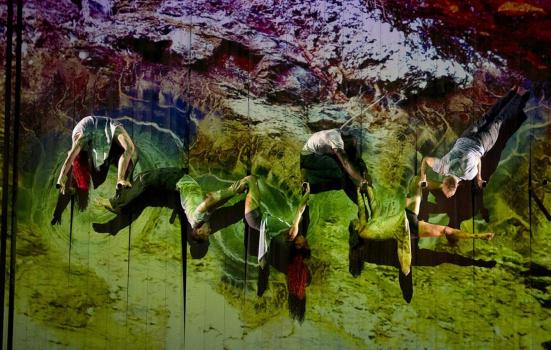International touring has given Motionhouse greater confidence and is a crucial element in the company's plans for the future. Louise Richards explains why she plans ahead - and is ready for surprises.

Katja Ogrin
I founded Motionhouse with Kevin Finnan in 1988 in Leamington Spa, Warwickshire, with a vision to create dance theatre in a range of contexts. Now, our performances are rooted in dance but draw on theatre, circus, acrobatics and film. For many years we toured predominantly in the UK, with just the odd date overseas. The development of our outdoor work between 2005 and 2008 gave us an opening into European festival touring which we consolidated with a visit to Tarrega Festival in Spain, the sector’s marketplace, in 2009. Outdoor touring went from strength to strength but our theatre work remained within UK borders. Then the rise of social media, and specifically YouTube, meant we could upload our productions online for the world to see without the need to get past industry gatekeepers. Promoters searching for dance shows started getting in touch, which was how we landed our first international touring date for Scattered in Romania. When we arrived, our translator was not there, nor the equipment which the venue had been briefed to organise. Because the show is so technically demanding, when everything did arrive it was a close call whether the show would go up on time.
We could not get insurance to drive the JCBs a few yards down the street to the beach
Not put off, soon after we were contacted by global management company IMG Artists (IMGA). This opened up a whole new world of touring opportunities across Europe, North America and Asia, and working with IMGA meant that we had promoters on the ground. But there were vast differences in their approach: for example, in the US the marketing is very autonomous - we provide the toolkits and they extract everything they need from them. In Asia things do not always translate well and we nearly had to change the name of the production in Tokyo because the word ‘Scattered’ did not translate.
International audiences have responded very differently to our productions. In the UK our audiences are appreciative but relatively reserved. In America, we have become accustomed to whooping and hollering. When we performed Scattered in Tokyo, we were met with polite clapping and silent waving from the front row. At first, we were not sure whether this was good or bad, but we then learnt that waving is the equivalent of a standing ovation there. By contrast, audiences in China are vocal and often talk during the shows, even bringing their own tripods and recording devices.
Our performances tend to be around an hour long, but we have been advised that this is too long for US audiences without an interval. For our next US tour with Broken, we have to think about how to work an interval in, something we have never done before. It will mean considering not just how the dancers physically stop, but how we will rework the music and lighting.
We have also become experts in freight. We mostly ship everything by sea because it is more cost-effective, but it can take several weeks to arrive. Earlier this year we were touring the UK with Broken while the set for Scattered was en route by sea to the US. We needed some lighting equipment for both shows, so that had to go by air and it only made it to America just ahead of the dancers.
We have learnt to expect the unexpected, even with mundane things such as insurance. On a recent UK tour with our outdoor production Traction, which sees our dancers performing with JCB diggers on a beach, we could not get insurance to drive the JCBs a few yards down the street to the beach. So we ended up keeping them on the beach overnight and hiring security guards to keep an eye on them.
Having the opportunity to take our work to new audiences around the world and immerse ourserves in different cultures has been a truly enriching experience for everyone, from our artists to our administrators. International touring has given us greater confidence and it has become a crucial part of our plans for the future.
Here is my international touring checklist:
- Relationships: Establishing solid relationships with the people who are representing you is vital.
- Affordability: Always consider how you can make a tour affordable for people to book you, bearing in mind that your set will be out of action while in transit for some time.
- Visas: Organising work visas for everyone who will be travelling on tour can be a lengthy and complicated process. Things can go wrong that are out of your control so try and allow extra time for this.
- Insurance: Getting the right insurance is crucial and can be complex. You need to insure sets, equipment and people.
- Networks: Talking to other dance managers with experience of international touring to share experiences is really useful.
- Planning: Planning ahead as much as possible will help you no end, but bear in mind that every country operates so differently – some countries book tours with five months to go while some book within just five weeks.
Louise Richards is Executive Director of Motionhouse.
www.motionhouse.co.uk




